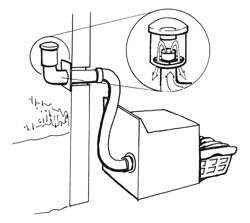Operation of dryers, both electric and gas-fired, is pretty straight forward: they work by heating and aerating clothes. Recent research shows that the energy use of currently available dryers differs by as much as 30%. Dryers are not required to display the EnergyGuide label, and there is no ENERGY STAR program for them, so it can be difficult to know which products are most efficient. This may soon change as interest in energy-saving opportunities in dryers grows and as new high-efficiency dryers (including heat pump dryers) are introduced in the U.S. In the meantime, consider the following features when you’re in the market for a new clothes dryer.
Gas vs. Electric
In terms of energy use in the home, the performance of electric and gas dryers does not vary widely. However, when including the energy used to convert and deliver electricity and natural gas to the home, standard gas models use much less energy—about one-third as much as comparable electric models—translating into reduced fuel use as well as lower CO2 and other pollutant emissions, Gas dryers are typically less expensive to operate than electric models, but savings vary depending on energy costs in your area. Electric ignition is required for all new gas dryers, eliminating the standing pilot lights found on older models as well as the associated energy waste and safety concerns. One downside to gas is the potential introduction of combustion byproducts in your home if the unit is not vented properly.
Automatic Shut-off
Other than fuel type, the major energy consideration is whether the dryer uses termination controls to sense dryness and turn off automatically and, if so, the sensing mechanism used. Dryers used to be controlled simply by setting a timer. You guessed how long it would take to dry a particular load of laundry and set the timer for 60 minutes or 75 minutes, etc. If the clothes came out dry, chances are you continued to use that setting. However, some types of clothes dry much more quickly than others. You can save a significant amount of energy by buying a model that senses dryness and automatically shuts off. Most of the better-quality dryers today include this feature.
The best dryers have moisture sensors in the drum for sensing dryness, while others only infer dryness by sensing the temperature of the exhaust air. The lower-cost thermostat-controlled models may overdry some types of clothes, but even these are much better than timed-dry machines. Compared with timed drying, you can save about 10% with a temperature-sensing control and 15% with a moisture-sensing control. Overdrying can reduce the life of clothes, so getting the timing right saves money in your clothing budget as well.
Features That Reduce the Need for Ironing
While the energy used for ironing clothes is not technically part of the energy used for washing or drying clothes, it is closely related. If clothes are taken out of the dryer while still slightly damp and then hung up, they may not need ironing. Moisture-sensing automatic shut-off helps here — especially if the dryer includes a feature to adjust the level of dryness desired. Wrinkling can also be reduced with a cool-down (fluff) cycle and by a feature that tumbles the clothes periodically after the end of the cycle if the clothes are not removed right away. Be aware, however, that the “wrinkle-guard” cycle on some models tumbles clothes continuously for an hour or so after the cycle completes, increasing energy use by about 10%. Look for models with moisture-sensors and periodic tumbling to minimize wrinkling and energy use.
Ready to Buy? Check out the Enervee Marketplace
ACEEE’s partner, Enervee, makes it simple to find the best deals from your favorite retailers on the most energy efficient dryers that meet your needs.
Installing Dryers
The most important part of the dryer installation is the exhaust system. In most cases — and always with gas dryers, the exhaust should vent to the outside, using as short and straight a section of smooth metal ducting as possible. Ducts that are unobstructed and minimize friction encourage better airflow, which improves efficiency and drying time. Take care when using flexible duct because if compressed or crushed behind the dryer, airflow will be restricted. If you do use flex duct, only use foil or aluminum types; plastic or vinyl will not hold up to the high temperatures of the dryer. Dryer vent hoods are available that seal very tightly when the dryer blower is not on. Standard dryer vent hoods have a simpler flapper that is not as effective. Ask your appliance salesperson about dryer vent systems and spend the extra $15 to $20 to buy a tight-sealing one.
Electric dryers may be vented inside the home during the winter months if the house air is dry and if the air vent is properly filtered. Compact electric dryers in apartments and condos are sometimes installed for indoor venting. If the electric dryer is vented inside, watch for moisture on the windows, which would indicate that you’re introducing too much moisture into the house.


